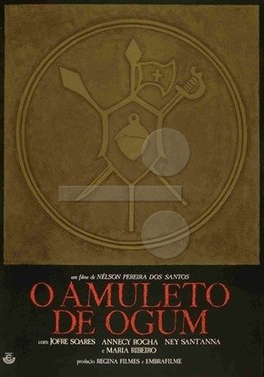
The Southern Oceanic languages are a linkage of Oceanic languages spoken in Vanuatu and New Caledonia. It was proposed by John Lynch in 1995 and supported by later studies. It appears to be a linkage rather than a language family with a clearly defined internal nested structure.
Sakao is an Oceanic language spoken on the northeast horn of Espiritu Santo, Vanuatu.
Tangoa, or Leon Tatagoa, is an Oceanic language spoken on Tangoa Island, south of Espiritu Santo Island in Vanuatu. The community was an early settlement for Christian missionaries, leading to its use as a lingua franca in the area, having largely displaced the moribund Araki language spoken on Araki Island.
Ngen, or Shark Bay, is one of the East Santo languages group of languages. It is spoken on Espiritu Santo in Vanuatu. It has about 450 speakers. It is close to Lorediakarkar.

The languages of South America can be divided into three broad groups:

The Amulet of Ogum is a 1974 Brazilian drama film directed by Nelson Pereira dos Santos. It was entered into the 1975 Cannes Film Festival. It was also selected as the Brazilian entry for the Best Foreign Language Film at the 48th Academy Awards, but was not accepted as a nominee.
Kiai is an Oceanic language spoken by about 450 people in the central highlands of Espiritu Santo island, in Vanuatu.
The Juruna language, also known as Yudjá, is spoken in Brazil. It is spoken in the Xingu Indigenous Park of Mato Grosso state. In 2001 there were 278 native speakers. It is the last survivor of the Yuruna languages.
Amonap, also known as Apalakiri, is a Cariban language spoken by the Kuikuro and Kalapalo peoples of Brazil, and formerly by the Matipu. It is spoken in seven villages along the Culuene River in the Xingu Indigenous Park of Mato Grosso.
Blaan, also known as Bilaan, is an Austronesian language of the southern Philippines spoken by an indigenous ethnic group of the same name who inhabited many areas of Soccksargen and Davao Occidental.
Sarangani is a Manobo language of the Davao Region of Mindanao in the Philippines.
Silacayoapan is one of the more extensive Mixtec languages. It is spoken by 150,000 people in Puebla and across the border in Guerrero, as well as by emigrants to the United States.
Butmas, also Butmas-Tur or Farafi, is a language of the interior of Santo Island in Vanuatu.
Polonombauk is a language of the interior of the southeast of Santo Island in Vanuatu.
Albarradas Zapotec, in full Santo Domingo Albarradas Zapotec, is a Zapotec language of Oaxaca, Mexico. It is spoken in the towns of Santa María Albarradas, Santo Domingo Albarradas, and San Miguel Albarradas. The language of neighboring Santa Catarina Albarradas and San Antonio Albarradas is not mutually intelligible.
Tutuba is an Oceanic language spoken in Vanuatu on the southeast tip of Espiritu Santo Island and on Tutuba Island offshore.
Valpei (Valpei-Hukua) is an Oceanic language spoken on the northern tip of Espiritu Santo Island in Vanuatu.
Wusi (Wusi-Kerepua) is an Oceanic language spoken on the west coast of Espiritu Santo Island in Vanuatu.
Aore is a recently extinct Oceanic language spoken on Aore Island, just off Espiritu Santo Island in Vanuatu.
The Espiritu Santo languages are a group of North Vanuatu languages spoken on Espiritu Santo Island in northern Vanuatu. Tryon (2010) considers the Espiritu Santo languages to be a coherent group.
Moseley, Christopher and R. E. Asher, ed. Atlas of the Worlds Languages. (New York: Routelage, 1994)



